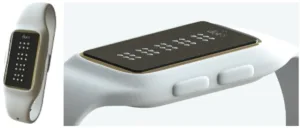The worldwide Braille literacy rate is low and dropping. One reason for this is that Braille reading devices are expensive. To address this issue, startup company Dot Incorporation (Seoul, South Korea) has produced an inexpensive, Braille smartwatch.
Located on the face of the watch is an array of so-called active dots. The dots are active in the sense that each of the “dull pins” can be physically raised and lowered. The pins are arranged in four cells, each cell containing six active dots. The user places their finger on top of the array to read the Braille text. Users can adjust the speed with which the smartphone spells out the Braille text. The speed adjustment makes it possible for an experienced user to read rapidly or a beginner to go slowly taking the time needed to recognize the Braille words.
To the extent that early reviews offer any criticism of the Dot smartwatch, it relates to the fact that the display will sometimes present only part of a word at any given time. This apparently makes reading Braille more difficult.
The Dot smartwatch can communicate with other devices via Bluetooth 4.0. This link allows the Dot smartwatch to convert text into Braille letter equivalents using an app such as iMessage and to do so through the use of user voice commands. More than that, this capability allows the Dot smartwatch to act as an e-reader. This is significant because less than 1% of books are ever translated into Braille.
Other functions of the Dot smartphone include a messaging system that allows communication with others, a navigation function, an alarm and a timepiece. The Dot smartwatch can also be used to remind the user of an event.
The Dot smartphone is reported as having a battery life of about 10 hours when in active use. This translates to roughly five days of standby time.
It is, perhaps, worthwhile to mention one particular feature of the Dot Braille smartwatch. It has a built-in Braille learning system that can assist users in mastering the ability to read Braille. The reason this is significant is that the US based National Federation of the Blind estimates that just 10% of visually impaired people actually learn Braille.
The Dot team reports having plans to create a Braille module for bank ATMs. Beyond that, the company’s intention is to modify the Braille module for use in public transportation applications and in home appliances. Ultimately, the team plans to manufacture an affordable tablet like device that can produce shapes and mathematical equations as well as text. This will be accomplished through the use of multiple Braille cell arrays.
The company is currently accepting pre-orders for the Dot smartwatch at what seems to be a highly affordable price of just under $300. The Dot smartphone is expected to start shipping this December. – Arthur Berman
Dot Incorporation, Eric Kim, [email protected], +82-10-8709-7468

